
Rostock, officially the Hanseatic and University City of Rostock, is the largest city in the German state of Mecklenburg-Vorpommern and lies in the Mecklenburgian part of the state, close to the border with Pomerania. With around 210,000 inhabitants, it is the third-largest city on the German Baltic coast after Kiel and Lübeck, the eighth-largest city in the area of former East Germany, as well as the 39th-largest city of Germany. Rostock was the largest coastal and most important port city in East Germany.

Warnemünde is a seaside resort and a district of the city of Rostock in Mecklenburg, Germany. It is located on the Baltic Sea and, as the name implies, at the estuary of the river Warnow. Warnemünde is one of the world's busiest cruise ports.

Celestyal Discovery is a cruise ship, built in 2003 by the German shipyard Aker MTW in Wismar, and was operated by AIDA Cruises for twenty years as AidaAura, as was her sister ship AIDAvita. In November 2023 the ship was sold to the Greek cruise line Celestyal Cruises and entered service in March 2024.

The Hanse Sail in Rostock is the largest maritime festival in Mecklenburg (Germany) and one of the largest in Europe.

The Leibniz Institute for Baltic Sea Research is a research institution located in Warnemünde (Rostock), Germany.
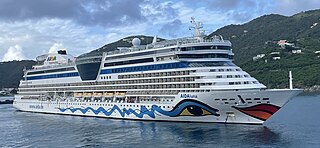
AIDAluna is a Sphinx-class cruise ship, owned by US based Carnival Corp and operated by AIDA Cruises. Built by Meyer Werft shipyards in Papenburg, Germany, she is the third ship of the class, preceded by AIDAdiva and AIDAbella, and is followed by AIDAblu, AIDAsol, and AIDAmar. The ship has a capacity of 2,100 passengers and has a gross tonnage of 69,203. AIDAluna was initially deployed in the Baltic Sea for the 2009 Summer season. In Winter 2009, she was redeployed in Canary Islands. AIDAluna has an 8 × 4.5-m poolside theater, which is a first for AIDA Cruises.

J.R. Tolkien is a gaff-topsail schooner of Netherlands registry used for passenger cruises on the Baltic Sea and elsewhere in European waters.

The Baltic is a German emergency tow vessel (ETV) commissioned in 2010.

Großherzogin Elisabeth is a 1909 German sailing ship built as the San Antonio, a replacement for the 1907 freighter San Antonio which had been lost in a collision at sea.
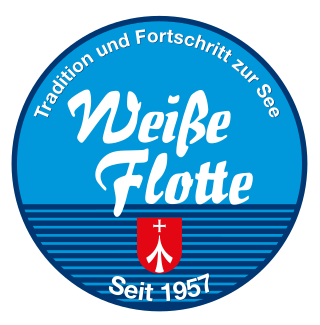
The Weiße Flotte is a shipping company with its head office in Stralsund, Germany, that offers passenger and car ferry services as well as excursions by boat, especially along the Baltic Sea coast of the state of Mecklenburg-Western Pomerania.

The A-Rosa Aqua is a German river cruise ship, cruising in the Rhine – Main – Moselle basin. The ship was built by Neptun Werft GmbH at their shipyard in Warnemünde, Germany, and entered service in July 2009. Her sister ships are A-Rosa Brava and A-Rosa Viva. Her home port is currently Rostock.

Rostock Port is a large German port on the Baltic Sea, it is located on the Unterwarnow estuary in the city of Rostock. Most of the port infrastructure is owned by Rostock Port GmbH, a joint venture between the state of Mecklenburg-Vorpommern (25.1%) and the Hanseatic City of Rostock (74.9%). The port operations are carried out by Euroports Germany GmbH & Co. and other private companies. With a total throughput of 28.8 million tons (2017), the ports of Rostock is the fourth largest German port.
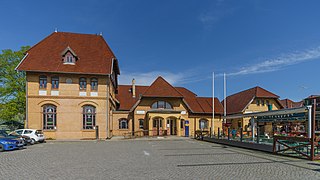
Warnemünde station is located in the seaside resort of Warnemünde, a district of the Hanseatic city of Rostock in the German state of Mecklenburg-Vorpommern. The station opened on 30 September 1903 and is located on the Neustrelitz–Warnemünde railway. It is the terminus of all three Rostock S-Bahn lines. In addition, some long-distance trains serve the station. Until 1995, it was the starting point of ferries to Gedser in Denmark. The station building and some other facilities of the station have heritage protection.
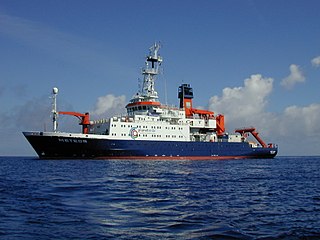
The RV Meteor is a multidisciplinary research vessel operating mainly on the high sea. She is owned by the German state represented by its Federal Ministry of Education and Research and registered in Hamburg.

The RV Sonne is a German deep ocean research vessel. The ship became available for science in December 2014 and it operates mainly in the Pacific and the Indian Oceans. She is registered in Wilhelmshaven and replaced its predecessor of the same name.

Bditel'nyy or Bditelnyy was a Project 1135 Burevestnik Large Anti-Submarine Ship or Krivak-class frigate that served with the Soviet and Russian Navies. Launched on 28 March 1970, the vessel served as part of the Baltic Fleet but operated more widely than the Baltic Sea, demonstrating the emerging blue water capability of the Navy. A dedicated anti-submarine vessel, with an armament built around the Metel system, the ship spent the period between 26 December 1970 and 30 September 1971 undertaking trials and tests to prove the new systems. During that time General Secretary Leonid Brezhnev and Admiral of the Fleet Sergey Gorshkov were both hosted on board. The vessel then subsequently undertook tracking of submarines in the Baltic, Black and Mediterranean Seas, and even travelled as far as Cuba, crossing the Atlantic Ocean. The ship also visited friendly ports like Annaba in Algeria, Gdynia in Poland and Rostock in East Germany. With the end of the Cold War, the ship also travelled to Belgium and visited Antwerp. During June 1993, Bditelnyy took part in BALTOPS-93, the first joint exercise between NATO and Russia. However, soon afterwards, the ship was retired and, on 31 July 1996, decommissioned and subsequently broken up.
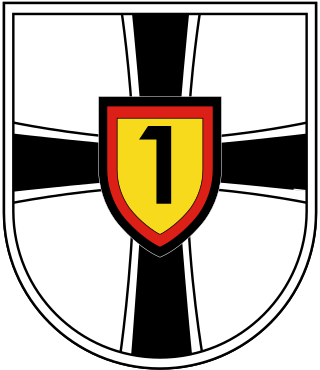
Einsatzflottille 1 is one of the three brigade-level units of the German Navy, in addition to Einsatzflottille 2 and the Naval Air Command. It is based in Kiel, Schleswig-Holstein, and is under the head of the Navy Command, based in Rostock.
The Institut für Meereskunde in Kiel, Germany, existed from April 1, 1937 to January 1, 2004. It was an essential element of the long history of marine sciences in Kiel. This history started with the work of Samuel Reyher published in 1697 and is today continued within the GEOMAR Helmholtz Centre for Ocean Research Kiel.

R/V Aurora is a Danish research vessel, owned and operated by Aarhus University. The ship is named after Aurora, Roman goddess of the dawn. It is rigged as a multi-purpose vessel, with a large working deck and gantry for deployment and recovery of trawl and heavy equipment over the stern. Aurora is classified to sail in the Baltic and the North Sea, east of 3° east and south of 62° north, with an endurance of up to 10 days at sea.

The Humanity 1 is a German Search and Rescue Ship. The former German research ship is owned by SOS Humanity, having previously been owned by Sea-Watch e. V., who use the ship for SAR operations of refugees in distress on the Mediterranean Sea. Previously, the GEOMAR Helmholtz Centre for Ocean Research Kiel (GEOMAR) operated the ship under the name of Poseidon, after the Greek god of the sea, with the State of Schleswig-Holstein as the owner. In January 2020 the ship was auctioned and bought by Sea-Watch e. V. and renamed Sea-Watch 4 on 20 February 2020; the ship was further re-named, to Humanity 1, in August 2022.





















